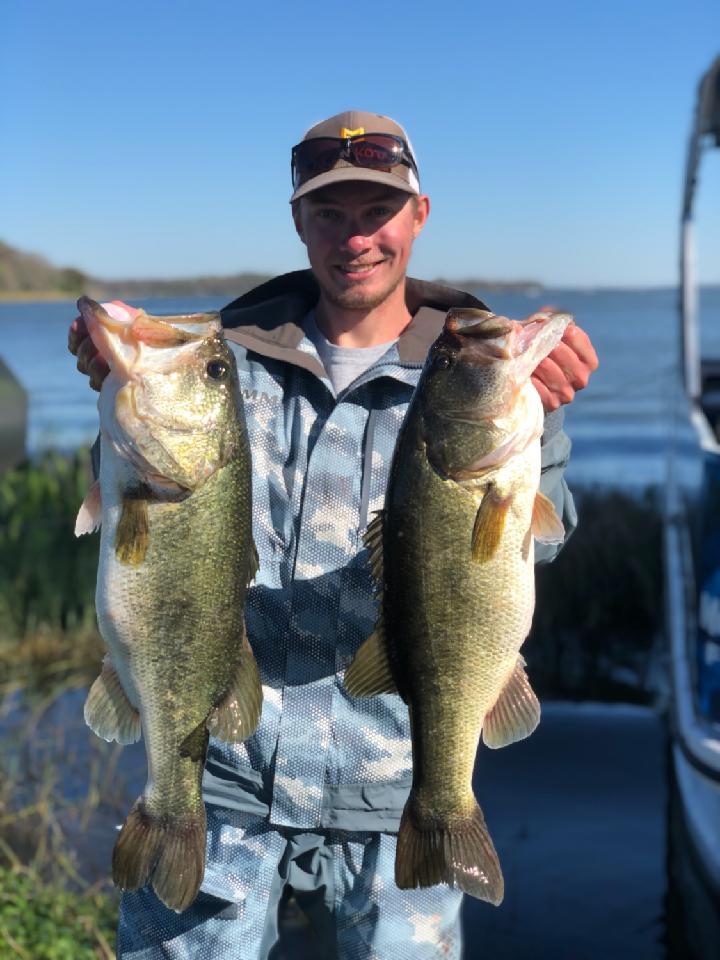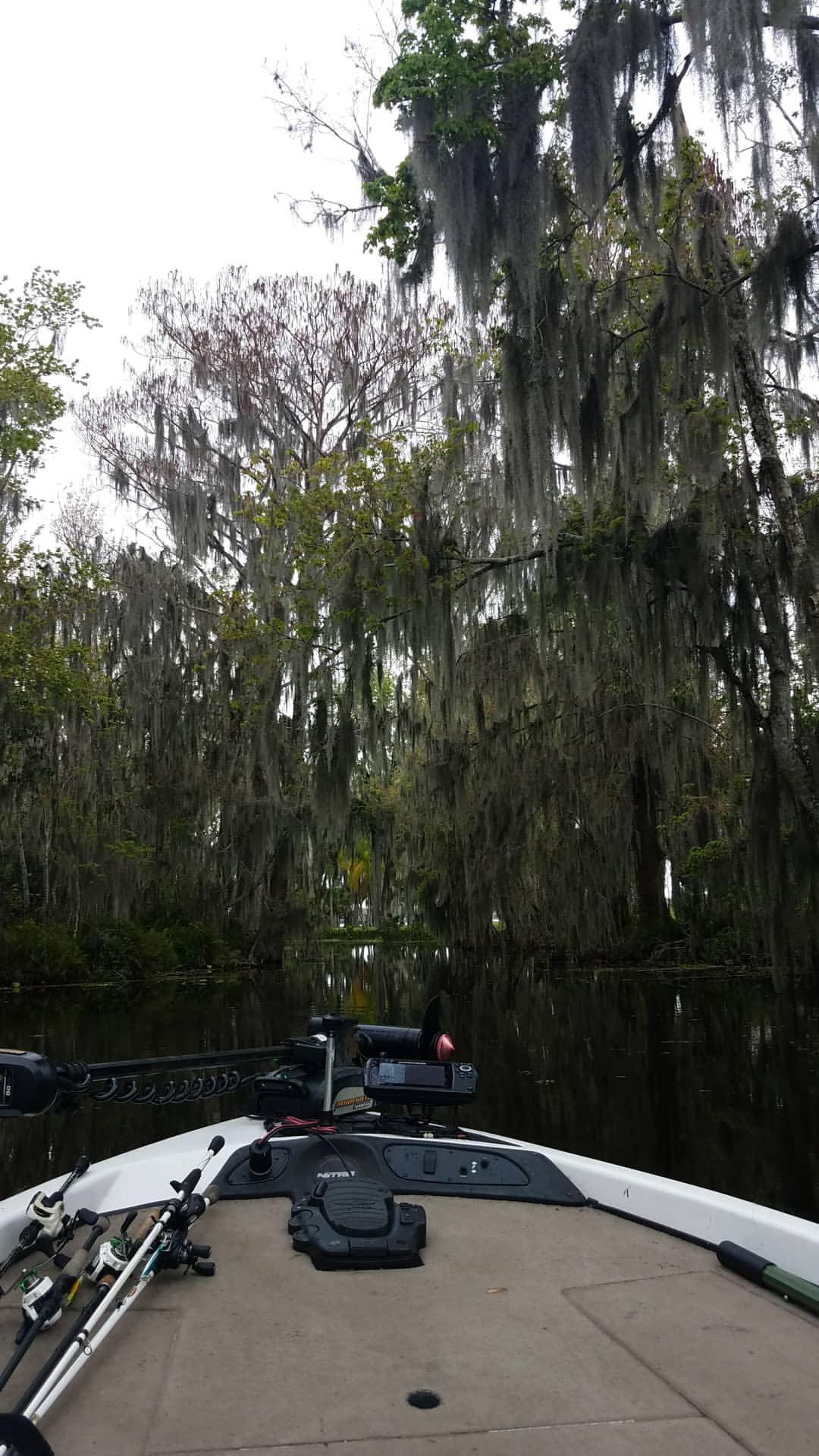Florida Bass Fishing: Expert Tactics, Best Lakes, Seasons, and Regulations
By: FishUSA Staff
August 22, 2025
Florida is a bass angler’s paradise — from world-famous largemouth bass lakes like Okeechobee and Toho to the tropical canals holding exotic peacock bass in South Florida. With warm water year-round, diverse habitats, superior genetics, and abundant forage, Florida produces trophy bass opportunities in every season. This guide delivers expert tactics, gear recommendations, seasonal strategies, and a breakdown of the state’s top bass fishing waters.
Florida is a bass angler’s paradise — from world-famous largemouth bass lakes like Okeechobee and Toho to the tropical canals holding exotic peacock bass in South Florida. With warm water year-round, diverse habitats, superior genetics, and abundant forage, Florida produces trophy bass opportunities in every season. This guide delivers expert tactics, gear recommendations, seasonal strategies, and a breakdown of the state’s top bass fishing waters.

Table of Contents
How to Fish for Bass in Florida
Florida bass are opportunistic predators. In shallow, vegetation-rich lakes, they ambush from hydrilla, pads, and bulrush. In deeper reservoirs and rivers, they relate to submerged structure and bait schools. Successful anglers adapt presentations to match seasonal movements, water clarity, and forage activity.
Flipping & Pitching (Vegetation Mastery)
- When: Year-round, but especially effective in spring spawn and summer midday heat.
- How: Use a 7’6”–8’ heavy-power rod, 50–65 lb braid, and a pegged 1/2–1 oz tungsten weight. Pitch creature baits into pad stems, mats, and cane holes.
- Targets: Thick mats, pencil reeds, cattails, hyacinth edges, and isolated pads.
Pro Tip: In summer, target the shady side of vegetation where oxygen is higher and bass are cooler.
Topwater (Explosive Morning & Evening Bites)
- When: Early mornings, late evenings, and overcast days.
- How: Walk-the-dog with a spook, chug with a popper, or work a hollow-body frog over pads and grass mats.
- Tip: Pause near open holes in vegetation — bass often strike on the stop.
Crankbaits & Moving Baits (Covering Water)
- When: Pre-spawn, post-spawn, and fall bait migrations.
- How: Medium-diving crankbaits for submerged grass edges, lipless cranks for covering flats, and spinnerbaits when water is stained.
- Colors: Shad patterns in clear water; chartreuse/white in stained water.
Soft Plastics (Florida Staple)
- When: All seasons, adaptable to multiple rigs.
- How: Texas-rigged worms, Senkos wacky-style, or Carolina rigs for deeper structure. Swim a soft paddle-tail through submerged hydrilla.
- Bonus: Junebug, watermelon red, and black/blue are Florida confidence colors.

Dialed-In Gear & Lure Selection
Rods & Reels
- Flipping/Pitching: 7’6”–8’ heavy-power, fast-action baitcasting rods; high-speed reels (7:1+).
- Topwater/Moving Baits: 6’10”–7’3” medium-heavy rods; 6.3–7.3:1 baitcasters or 3000-size spinning reels.
- Finesse: 6’10”–7’ medium spinning rods for wacky rigs, shaky heads, and drop shots in clear water.
Line
- Fluorocarbon (12–20 lb) for crankbaits, worms, and jigs in clear to stained water.
- Braid (50–65 lb) for heavy vegetation and frogging.
- Monofilament (12–15 lb) for topwater walking baits and poppers.
Lures
- Soft Plastics: Worms, Senkos, creature baits, flukes.
- Topwater: Frogs, poppers, walking baits, prop baits.
- Moving Baits: Spinnerbaits, chatterbaits, swimbaits, crankbaits.
- Punching Rigs: Heavy tungsten weights (1–2 oz), creature baits, straight-shank hooks.
Electronics
- Side imaging to find offshore shell beds and submerged grass edges.
- Forward-facing sonar for tracking schooling fish and suspended bass.
- GPS mapping to mark productive vegetation lines and waypoints.
When to Go Bass Fishing in Florida (Month-by-Month)
- January–February: Pre-spawn begins in southern Florida; flip isolated pads and fish lipless cranks along grass lines.
- March–April: Peak spawn statewide. Sight-fish beds in clear water and work soft plastics slowly.
- May–June: Post-spawn feeding; topwater bite peaks at dawn/dusk, and shad spawns occur.
- July–August: Summer heat drives bass under thick mats — punching and frogging excel.
- September–October: Fall feeding frenzy; chase schooling bass with moving baits and topwater.
- November–December: Fish transition to winter patterns; slow down presentations and target stable water temps.

Best Bass Lakes & Hotspots In Florida
Florida is stacked with legendary bass fisheries, and while each water has its own personality, they all share the potential to produce giant fish if you approach them right. Here’s how I fish them, season by season and condition by condition.
Lake Okeechobee
The “Big O” is Florida’s crown jewel and one of the most famous bass lakes in the world. This massive, vegetation-rich fishery fishes like a living jungle — reeds, hydrilla, hyacinth mats, and eelgrass stretch for miles. In the spring, I target reed edges and scattered pad fields in the Harney Pond, South Bay, and Monkey Box areas with soft plastics like Senkos and creature baits on heavy flipping gear. During the shad spawn, I work topwaters and spinnerbaits tight to grass edges at first light. In summer, the bite pushes under thick mats where punching with 1–1.5 oz tungsten and a beaver-style bait is the only way to get them out.
Lake Tohopekaliga (Lake Toho)
Lake Toho has earned a reputation for producing monster bass during the spawn. Its hydrilla lines, submerged grass flats, and lily pad fields create prime staging and spawning habitat. My favorite pattern here in January–March is to pitch a Texas-rigged creature bait along hydrilla edges in Shingle Creek or Goblets Cove. In post-spawn, I switch to swim jigs and chatterbaits to cover water and find feeding fish on outside grass lines. Cloudy days in summer can bring a strong topwater bite over scattered pads.
Rodman Reservoir
Rodman is a timber-filled impoundment that fishes completely differently than Florida’s open shallow lakes. Massive submerged stumps, laydowns, and hydrilla beds make it ideal for flipping and pitching heavy jigs or Texas rigs. I’ve had my best days here in February and March, flipping jigs into timber in 8–12 feet and dragging big worms along the outside grass lines. It’s also one of the few Florida lakes where I’ll lean on crankbaits for bass holding off main-lake structure.
Harris Chain of Lakes
The Harris Chain offers a mix of open-water shell bars, boat docks, canals, and expansive grass lines. Lakes Harris, Eustis, Dora, and Griffin are all connected, giving you options depending on weather and water clarity. Pre-spawn, I like to crank or Carolina rig shell beds in the main lakes. During the spawn, the canals and backwaters load with fish — perfect for flipping or skipping wacky rigs under docks. In summer, offshore hydrilla beds become key, and working a big ribbon-tail worm or deep crank can produce some serious weight.
Lake Kissimmee
Lake Kissimmee is part of the Kissimmee Chain and features massive vegetation lines, offshore hydrilla patches, and classic Florida spawning bays. My go-to spring pattern is to target spawning flats with wacky Senkos and weightless flukes. Once the post-spawn sets in, I shift to working topwaters at dawn over hydrilla edges before the sun pushes bass deeper into the grass. Summer here is prime for punching mats and fishing frogs over the thickest cover you can find.
Lake Istokpoga
Istokpoga is a large, shallow lake with dense vegetation, making it a flipper’s dream. I spend most of my time here working pencil reeds, bulrush, and lily pad fields with a 1 oz tungsten and a compact creature bait. The lake also produces great numbers during the shad spawn when spinnerbaits and chatterbaits can load the boat quickly. The key to Istokpoga is moving until you find the right stretch holding active fish — they tend to group up here more than most lakes.
Stick Marsh / Farm 13
Stick Marsh/Farm 13 is one of the premier big-bass waters in Florida, especially during the cooler months. The hydrilla here holds fish year-round, but the winter and pre-spawn periods are unmatched. I’ve caught multiple fish over eight pounds here in January by slow-rolling swimbaits and working lipless crankbaits along hydrilla lines. As the day warms, pitching soft plastics into isolated hydrilla clumps can produce giants.
St. Johns River
The St. Johns fishes like a moving-water lake system, with current breaks, shell bars, and eelgrass beds providing year-round habitat. In the spring, I like to target spawning bays off the main river with soft plastics. In summer, working crankbaits along main-channel shell bars and fishing topwaters around eelgrass beds can produce consistent action. Tidal influence means you have to pay attention to current — falling water often positions bass tight to cover.

Miami Canals
The Miami canal systems are a unique fishery offering the chance to catch both largemouth and exotic peacock bass in the same trip. Clear water makes sight-fishing a major part of the game, and I’ve had great success here with jerkbaits, small swimbaits, and topwaters. The best action for peacocks is during warmer months, while largemouth can be caught year-round by targeting deeper holes and shaded structure.

Water Clarity, Weather & Pressure Adjustments
Clarity
- Clear: Downsize line, use natural bait colors, and apply finesse presentations.
- Stained: Use chartreuse, black/blue, and vibration-heavy baits.
- Muddy: Slow down, use bulkier baits, and focus on heavy cover close to shore.
Weather
- Pre-front: Bass feed aggressively; use moving baits to cover water.
- Post-front: Expect a tougher bite; flip heavy cover and use slower presentations.
- Wind: Fish wind-blown points and grass edges where bait is pushed in.
Pressure
- Change lure profile and presentation speed after fishing pressure increases.
- Fish secondary spots — subtle grass lines and small isolated cover — away from crowds.
- Downsize bait in clear, pressured water.
Licenses & Regulations (Overview)
- License: Freshwater license generally required for anglers 16+ (check FWC rules).
- Statewide Rules: Daily bag limit of 5 bass, only one may be 16 inches or longer.
- Special Regulations: Certain trophy waters have catch-and-release only for largemouth bass.
Regulations can change annually — check the Florida Fish & Wildlife Conservation Commission for updates before fishing.
Quick FAQs
When’s the best time for trophy bass?
January–March during the pre-spawn and spawn produces the biggest fish.
What’s the best all-around bait?
A soft-plastic worm — Texas or wacky rigged — works in nearly every condition in Florida.
Do I need a boat?
No, many Florida lakes have excellent bank access, but a boat allows you to reach offshore grass lines and hidden structure.
Final Thoughts
Florida’s bass fishing is world-class. Whether you’re punching mats on Okeechobee, walking a frog over Kissimmee’s pads, or chasing peacock bass in Miami’s canals, the variety and quality are unmatched. Adapt to the seasons, understand the forage, and you’ll have consistent success year-round.

